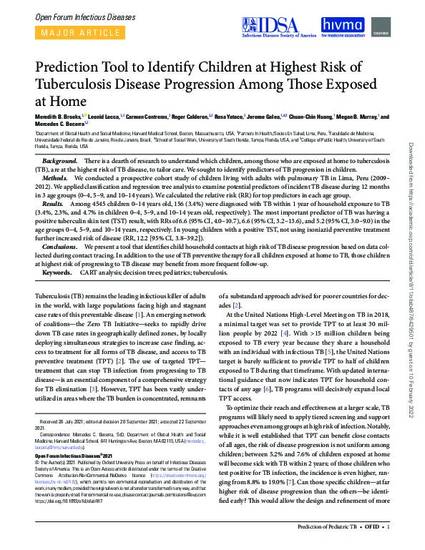
- CART analysis,
- decision trees,
- pediatrics,
- tuberculosis
Background: There is a dearth of research to understand which children, among those who are exposed at home to tuberculosis (TB), are at the highest risk of TB disease, to tailor care. We sought to identify predictors of TB progression in children.
Methods: We conducted a prospective cohort study of children living with adults with pulmonary TB in Lima, Peru (2009–2012). We applied classification and regression tree analysis to examine potential predictors of incident TB disease during 12 months in 3 age groups (0–4, 5–9, and 10–14 years). We calculated the relative risk (RR) for top predictors in each age group.
Results: Among 4545 children 0–14 years old, 156 (3.4%) were diagnosed with TB within 1 year of household exposure to TB (3.4%, 2.3%, and 4.7% in children 0–4, 5–9, and 10–14 years old, respectively). The most important predictor of TB was having a positive tuberculin skin test (TST) result, with RRs of 6.6 (95% CI, 4.0–10.7), 6.6 (95% CI, 3.2–13.6), and 5.2 (95% CI, 3.0–9.0) in the age groups 0–4, 5–9, and 10–14 years, respectively. In young children with a positive TST, not using isoniazid preventive treatment further increased risk of disease (RR, 12.2 [95% CI, 3.8–39.2]).
Conclusions: We present a tool that identifies child household contacts at high risk of TB disease progression based on data collected during contact tracing. In addition to the use of TB preventive therapy for all children exposed at home to TB, those children at highest risk of progressing to TB disease may benefit from more frequent follow-up.
Open Forum Infectious Diseases, v. 8, issue 11, art. ofab487
Available at: http://works.bepress.com/jerome-galea/102/
